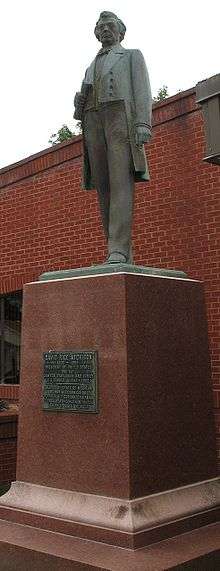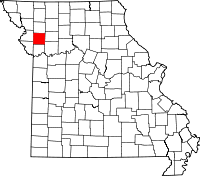Plattsburg, Missouri
| Plattsburg, Missouri | |
|---|---|
| City | |
 Location of Plattsburg, Missouri | |
| Coordinates: 39°33′52″N 94°27′12″W / 39.56444°N 94.45333°WCoordinates: 39°33′52″N 94°27′12″W / 39.56444°N 94.45333°W | |
| Country | United States |
| State | Missouri |
| County | Clinton |
| Area[1] | |
| • Total | 3.63 sq mi (9.40 km2) |
| • Land | 3.60 sq mi (9.32 km2) |
| • Water | 0.03 sq mi (0.08 km2) |
| Elevation | 948 ft (289 m) |
| Population (2010)[2] | |
| • Total | 2,319 |
| • Estimate (2012[3]) | 2,290 |
| • Density | 640/sq mi (250/km2) |
| Time zone | Central (CST) (UTC-6) |
| • Summer (DST) | CDT (UTC-5) |
| ZIP code | 64477 |
| Area code(s) | 816 |
| FIPS code | 29-58250 [4] |
| GNIS feature ID | 0730179 [5] |
| Website | plattsburgmo.com |

Plattsburg is a city and county seat of Clinton County, Missouri, United States,[6] which is located along the Little Platte River. As of the 2010 census, the city population was 2,319.
History
The area along the rivers had been occupied for thousands of years by indigenous peoples. Historic American Indian tribes in the area included the Ioway, Fox and Sac tribes, who ceded land in what became northwest Missouri in the Platte Purchase.
The European-American settlers first called their settlement Concord. (This has been used for a contemporary man-made lake and surrounding housing development in the city.) Later the city was renamed Springfield. After the discovery of a preceding Springfield, Missouri, settlers named it "Plattsburg," after Plattsburgh, New York, which is the seat of Clinton County, New York. Both it and Clinton County, Missouri were named for George Clinton, one of the Founding Fathers, the first governor of New York, and vice president from 1805 to 1812.[7]
The area was settled chiefly by migrants from the Upper South, especially Kentucky and western Virginia, and was near what was called "Little Dixie" in Missouri. They brought their slaves and culture with them. For a brief period of time during the 1830s, Plattsburg was home to a Federal land office for areas of northern Missouri that were newly opened to settlement by European Americans after the Platte Purchase in 1836. Until then, Plattsburg was one of the farthest western non-military settlements.
The area became a leading producer of both hemp and tobacco, both major products of the Bluegrass Region of Kentucky and dependent on slave labor. David Rice Atchison, the US senator from here, was pro-slavery. As the county seat, Plattsburg was a center of trade and politics, with a variety of retail stores and professions.
By 1860, the county had a total population of 7,848, with 1,144 slaves, who were 17% of the total.[8] During the American Civil War, two minor battles took place nearby. The town was occupied by both Confederate and Federal forces. In 1863, elements of William Quantrill's guerrilla band captured a unit of Federal troops encamped in the county courthouse located in Plattsburg.
Geography
Plattsburg is located at 39°33′52″N 94°27′12″W / 39.56444°N 94.45333°W (39.564311, -94.453395).[9] According to the United States Census Bureau, the city has a total area of 3.63 square miles (9.40 km2), of which, 3.60 square miles (9.32 km2) is land and 0.03 square miles (0.08 km2) is water.[1]
Demographics
| Historical population | |||
|---|---|---|---|
| Census | Pop. | %± | |
| 1860 | 692 | — | |
| 1870 | 1,667 | 140.9% | |
| 1880 | 1,344 | −19.4% | |
| 1890 | 1,634 | 21.6% | |
| 1900 | 1,878 | 14.9% | |
| 1910 | 1,650 | −12.1% | |
| 1920 | 1,719 | 4.2% | |
| 1930 | 1,672 | −2.7% | |
| 1940 | 1,915 | 14.5% | |
| 1950 | 1,655 | −13.6% | |
| 1960 | 1,663 | 0.5% | |
| 1970 | 1,832 | 10.2% | |
| 1980 | 2,095 | 14.4% | |
| 1990 | 2,248 | 7.3% | |
| 2000 | 2,354 | 4.7% | |
| 2010 | 2,319 | −1.5% | |
| Est. 2014 | 2,258 | [10] | −2.6% |
The median income for a household in the city was $46,757, and the median income for a family was $56,250. Males had a median income of $44,450 versus $30,708 for females. The per capita income for the city was $22,401. About 9.0% of families and 13.9% of the population were below the poverty line, including 19.9% of those under age 18 and 9.3% of those age 65 or over.[12]
2010 census
As of the census [13] of 2010, there were 2,319 people, 936 households, and 612 families residing in the city. The population density was 644.1 people per square mile (252.1/km²). There were 1,080 housing units at an average density of 300 per square mile (117.4/km²). The racial makeup of the city was 90.3% White, 6.0% African American, 0.5% Native American, 0.1% Asian, 0.5% from other races, and 2.5% from two or more races. Hispanic or Latino of any race were 2.3% of the population.
There were 936 households of which 26.8% had children under the age of 18 living with them, 50.2% were married couples living together, 10.6% had a female householder with no spouse present, 4.6 had a male householder with no spouse present, and 34.6% were non-families. 30.9% of all households were made up of individuals and 12.3% had someone living alone who was 65 years of age or older. The average household size was 2.42 and the average family size was 3.02.
In the city the population was spread out with 26% under the age of 20, 5.4% from 20 to 24, 21.6% from 25 to 44, 28.9% from 45 to 64, and 18.1% who were 65 years of age or older. The median age was 43 years. The male population was 47.8%, which results in a 52.2% female population.
Notable people
- David Rice Atchison, US Senator (1844–1855) from Missouri, lived here and was buried here. Legend holds that he was "President for One Day," although historians and scholars reject this claim
- James C. Marshall, United States army officer, was born in Platteburg.
- O. O. McIntyre, noted New York newspaper columnist of early 20th Century.
- Riley Downing, vocalist/guitarist/songwriter for the band The Deslondes.
- Cory David Hall, noted pianist and composer
References
- 1 2 "US Gazetteer files 2010". United States Census Bureau. Retrieved 2012-07-08.
- ↑ "American FactFinder". United States Census Bureau. Retrieved 2012-07-08.
- ↑ "Population Estimates". United States Census Bureau. Retrieved 2013-05-30.
- ↑ "American FactFinder". United States Census Bureau. Retrieved 2008-01-31.
- ↑ "US Board on Geographic Names". United States Geological Survey. 2007-10-25. Retrieved 2008-01-31.
- ↑ "Find a County". National Association of Counties. Retrieved 2011-06-07.
- ↑ Clinton Co. MO Historical Society
- ↑ "Missouri: County-level Results for 1860", Historical Census Browser, University of Virginia Library, accessed 17 September 2011
- ↑ "US Gazetteer files: 2010, 2000, and 1990". United States Census Bureau. 2011-02-12. Retrieved 2011-04-23.
- ↑ "Annual Estimates of the Resident Population for Incorporated Places: April 1, 2010 to July 1, 2014". Retrieved June 4, 2015.
- ↑ "Census of Population and Housing". Census.gov. Retrieved June 4, 2015.
- ↑ http://factfinder2.census.gov/faces/tableservices/jsf/pages/productview.xhtml?pid=ACS_10_5YR_DP03
- ↑ http://factfinder2.census.gov/faces/tableservices/jsf/pages/productview.xhtml?pid=DEC_10_DP_DPDP1&prodType=table
External links
- City of Plattsburg
- Historic maps of Plattsburg in the Sanborn Maps of Missouri Collection at the University of Missouri
| |||||||||||||||||||||||||||||
| ||||||
